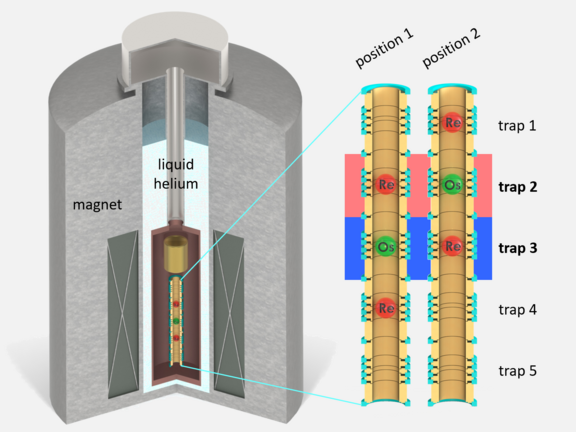How heavy are neutrinos? According to the standard model of elementary particle physics, they are massless, but since the discovery of neutrino oscillations (Nobel Prize 2015), it is clear that they must have a mass, albeit a tiny one. This periodic transformation of a neutrino into another of the three types resolves the once mysterious putative solar neutrino deficit. To date, only upper limits on the neutrino mass are known, confirming that it is extremely small. This makes a direct mass measurement a challenging task.
A promising approach is the precise measurement of radioactive beta decay, when in an atomic nucleus a neutron decays into a proton, an electron and a neutrino, or conversely of electron capture by a proton, which thereby converts into a neutron, also releasing a neutrino. Although the emitted neutrinos cannot be detected directly here, all the remaining energy released during the decay can. A comparison with the maximum available energy of the decay yields the neutrino mass. To do this, both values must be determined with high accuracy from the energy spectrum and its extrapolated maximum energy. The KArlsruhe TRItium Neutrino experiment KATRIN in Karlsruhe, for example, is working on this.
On the other hand, according to Einstein's famous formula E = mc², the maximum available energy is related to the mass difference between the mother and daughter atoms. To measure this very precisely – and independently of the decay process – mass spectrometry in Penning traps is an excellent method.
Precise mass measurements and highly accurate calculations provide decay energy
The most abundant rhenium isotope in nature is that with mass number 187; it decays with a very long half-life to the stable osmium-187, and the mass or energy difference, being only a few kiloelectronvolt (keV), is extraordinarily low. Members of Klaus Blaum's division at MPI for Nuclear Physics, using their "Pentatrap" apparatus, now succeeded in determining directly and highly precise the tiny mass difference between the two atoms in form of the 29-fold positively charged ions. To obtain the sought-after mass difference between the neutral atoms, the group led by Zoltan Harman in Christoph Keitel's division at MPIK precisely calculated the binding energy of the missing 29 electrons. This is the energy required to remove these electrons from the neutral atom.
Pentatrap is an array of five cylindrical Penning traps placed inside a strong superconducting magnet. “We first loaded the trap tower with a rhenium ion, then an osmium ion and again a rhenium ion, so that the three ions were trapped in adjacent individual traps,” Sergey Eliseev, who led the measurements, explains the procedure. “Then we measured the motion, or more precisely the orbital frequencies, of one rhenium ion and the osmium ion in their traps at the same time and then shifted all the ions by one trap such that the individual traps were now filled with the other ion. Afterwards we continued the measurement in the same traps and repeated the procedure many times.” This and further measures substantially reduced interferences and thus systematic uncertainties. The ratio of the orbital frequencies determined in this way yields the mass difference between the two 29-charged ions – with an accuracy of about one electronvolt (eV). This is the most precise mass-ratio determination ever.
“We calculated the binding energy of the outer 29 electrons in rhenium and osmium using three different relativistic quantum theoretical methods in a very elaborate way,” reports theory first author Chunhai Lyu. “These calculations, which must precisely account for the mutual interaction of the many electrons, ran for several weeks on hundreds of processors on our computer cluster. Fortunately, the result for the difference in binding energies is very similar for all three methods and accurate to within 1 eV overall.”
With this, the team has calculated the mass difference for the beta decay of rhenium-187 to osmium-187 to be 2470.9 ± 1.3 eV, which agrees very well with values obtained in previous measurements using cryogenic microcalorimetry. “This means,” summarises Sergey Eliseev, “that the underlying theoretical model of beta decay is valid and microcalorimetry is a reliable method in neutrino research, accurate at least in the range of a few electronvolt. Nevertheless, solid-state effects in rhenium crystals could alter the decay energy determined by microcalorimetry by few eV. Thus, in order to investigate these effects, further measurements with sub-eV uncertainties are required.”
Original publication:
Direct Q-value determination of the β–-decay of 187Re, P. Filianin, C. Lyu, M. Door, K. Blaum, W.J. Huang, M. Haverkort, P. Indelicato, C.H. Keitel, K. Kromer, Y.N. Novikov, A. Rischka, R.X. Schüssler, Ch. Schweiger, S. Sturm, S. Ulmer, Z. Harman, and S. Eliseev, Phys. Rev. Lett. 127, 072502 (2021), DOI: 10.1103/PhysRevLett.127.072502
